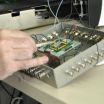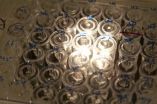(Press-News.org) The eye is not just a lens that takes pictures and converts them into electrical signals. As with all vertebrates, nerve cells in the human eye separate an image into different image channels once it has been projected onto the retina. This pre-sorted information is then transmitted to the brain as parallel image sequences. Scientists from the Max Planck Institute of Neurobiology in Martinsried have now discovered that fruit flies process optical information in a similar way. The evidence suggests that this type of wiring is an effective energy-saving mechanism and is therefore deployed by a diverse range of animal species. (Nature, November 11, 2010)
How does the mind perceive the world? This is not a trivial question: for many animal species, "seeing" is one of the most important senses. Every second, the eyes record a huge number of impressions which are converted by the photoreceptor cells into electrical signals. In vertebrates, image processing begins in the retina of the eye. Here, the nerve cells separate out the visual information in images featuring different content before transmitting them to the brain.
To understand something as complex as "seeing", scientists examine a somewhat simpler but extremely efficient system – the fruit fly's brain. Despite their tiny size, fruit flies are ideal candidates for such research: they are masters of visual processing; the number of nerve cells involved is manageable, which means that each individual cell can be examined; and genetic tools make it possible to block individual cells and analyse their role in the system.
Scientists at the Max Planck Institute of Neurobiology have now discovered surprising parallels in the neuronal processing of fruit flies and vertebrates. The fly also transmits images directly from the sensory cells to various image channels. The information is then transmitted via a series of other cells to large, motion-sensitive nerve cells. These output cells of the motion vision system are responsible for visual flight control.
Scientists ascertained the early separation into different images by blocking certain cells using genetic engineering. They then exposed the flies to moving striped patterns in an LED arena and recorded the electrical responses of the large output cells. The various contrast changes, which occur as a result of the stripe movement, are perceived by the eye's photoreceptors. However, five nerve cells – the lamina cells L1 to L5 – are located directly behind every sensory cell. "We had been wondering for a long time why there are so many cells, which of them transmit information to the motion vision system, and what kind of information this is," reports Alexander Borst, who headed up the study. His team suppressed the activity of individual lamina cells while the flies watched the moving patterns. The experiments revealed that L1 and L2 cells are the main input channels into the flies' motion vision system. It got exciting as the team discovered that the cells transmit only certain partial information: L1 only responds if a dark/bright edge passes by (light on), while L2 only transmits information about a moving bright/dark edge (light off). This represents a clear parallel with the eyes of vertebrates, where ON and OFF bipolar cells, as they are known, also respond only to specific contrast changes.
"It can be no coincidence that we find this separation of contrast information in all vertebrates and now also in flies," surmises Alexander Borst. The neurobiologist already has a theory as to why this wiring has been maintained so consistently throughout evolution: it allows the brain to save energy. If only one cell relayed the information about the various contrast changes, it would have to maintain a basic membrane voltage, which would intensify in a "light on" situation and weaken in a "light off" situation. Such a basic membrane voltage requires energy. Having two cells is therefore more efficient, as only one needs to be active when "its" contrast change occurs.
INFORMATION:
Original work:
Maximilian Jösch, Bettina Schnell, Shamprasad Varija Raghu, Dierk F. Reiff & Alexander Borst
ON- and OFF-pathways in Drosophila motion vision
Nature, online publication, November 11, 2010
Evolutionary bestseller in image processing
2010-11-11
ELSE PRESS RELEASES FROM THIS DATE:
Out-sniffing bomb-sniffing dogs
2010-11-11
Dogs have long been called man's best bomb detector –– until now.
A Tel Aviv University scientist leads a research team that has developed a powerful electronic sensor to detect multiple kinds of explosives –– including those used in the recent Yemeni bomb threat. Based on nanotechnology advances, the new sensor is small, portable, and is more sensitive and reliable at detecting explosives than any sniffer dog, says its lead researcher Prof. Fernando Patolsky of Tel Aviv University's Raymond and Beverly Sackler School of Chemistry.
With scientific findings on it published ...
GM, Chrysler bankruptcies created troubling legacy, legal scholars say
2010-11-11
CHAMPAIGN, Ill. — The Chrysler and General Motors bankruptcy reorganizations represented a sea change in corporate restructuring, one that could portend the end of our current system of bankruptcy reorganization, according to a published article by two University of Illinois experts in bankruptcy law.
Law professors Charles J. Tabb and Ralph Brubaker argue that the legal principles applied in the GM and Chrysler bankruptcies – two of the largest in U.S. history at $83.5 and $39.9 billion, respectively – were misguided, and ultimately have undermined the distributional ...
'Toxic toy crisis' requires fresh solutions
2010-11-11
Manufacturer recalls of toys, promotional drinking glasses, and other children's products constitute an ongoing "toxic toys crisis" that requires banning potentially harmful ingredients in these products and other changes in policy and practices. That's the conclusion of a new analysis in ACS' Environmental Science & Technology, a semi-monthly journal.
Monica Becker, Sally Edwards and Rachel Massey note that in June the United States government recalled 12 million promotional drinking glasses sold at a fast-food restaurant chain because the painted coating contained ...
Seeing the invisible: New CSI tool visualizes bloodstains and other substances
2010-11-11
Snap an image of friends in front of a window curtain and the camera captures the people - and invisible blood stains splattered on the curtain during a murder. Sound unlikely? Chemists from the University of South Carolina are reporting development of a camera with that ability to see the invisible, and more. Called multimode imaging in the thermal infrared, the new technology could find uses in crime scene investigations and elsewhere, they say in a series of three reports in ACS' Analytical Chemistry, a semi-monthly journal.
Michael Myrick, Stephen Morgan and their ...
DNA repair protein caught in act of molecular theft
2010-11-11
Scientists have observed, for the first time, an intermediate stage in the chemical process that repairs DNA methylation damage and regulates many important biological functions that impact health conditions such as obesity, cancer and diabetes.
The observations focused on the bacterial DNA repair protein AlkB, but the results also apply to several proteins in the same family that play key regulatory roles in humans. Armed with these results, researchers may one day develop methods for blocking the protein's efforts to perform the biologically important demethylation ...
Trojan Horse ploy to sneak protective drug into brains of stroke patients
2010-11-11
Scientists are reporting development of a long-sought method with the potential for getting medication through a biological barrier that surrounds the brain, where it may limit the brain damage caused by stroke. Their approach for sneaking the nerve-protective drug erythropoietin into the brain is medicine's version of the Trojan Horse ploy straight out of ancient Greek legend. It also could help people with traumatic head injuries, Parkinson's disease, and other chronic brain disorders. Their report appears in ACS' Molecular Pharmaceutics, a bi-monthly journal.
William ...
Soft drink could enhance effects of an anticancer drug
2010-11-11
Experiments with an artificial stomach suggest that a popular lemon-lime soft drink could play an unexpected role in improving the effectiveness of an oral anticancer drug. The experiments produced evidence that patients will absorb more of the unnamed drug, tested in Phase I in clinical trials, when taken with "flat" or degassed Sprite. The study appears in ACS' Molecular Pharmaceutics, a bi-monthly journal.
Faraj Atassi and colleagues note that efforts are underway to develop more anticancer medications that patients can take by mouth. However, biological variations ...
U of A researchers can predict heart transplant patient's health earlier
2010-11-11
Michael Mengel, a pathology researcher with the Faculty of Medicine & Dentistry, has found a new way to analyze biopsies from heart transplant patients by looking at their genes. This allows him to make an early prediction whether the transplant is working.
This is extremely important in heart transplant patients because a successful outcome depends completely on doing a biopsy of the heart tissue and prescribing treatments if necessary. In other organs transplants, doctors can use other measurements.
It's hoped the new technology and process developed in the Faculty ...
Guardian angels for seeds
2010-11-11
The seeds that you plant in your backyard garden next spring — and farmers sow in their fields — may have a guardian angel that helps them sprout, stay healthy, and grow to yield bountiful harvests. It's a thin coating of chemicals termed a "seed treatment" that can encourage seeds to germinate earlier in the season, resist insects and diseases, and convey other advantages. These new seed defenders are the topic of an article in the current issue of Chemical & Engineering News (C&EN), ACS' weekly newsmagazine.
C&EN Senior Business Editor Melody Voith describes a boom ...
Stress takes its toll in Parkinson's disease
2010-11-11
CHICAGO --- We all know that living a stressful lifestyle can take its toll, making us age faster and making us more susceptible to the cold going around the office.
The same appears to be true of neurons in the brain. According to a new Northwestern Medicine study published Nov. 10 in the journal Nature, dopamine-releasing neurons in a region of the brain called the substantia nigra lead a lifestyle that requires lots of energy, creating stress that could lead to the neurons' premature death. Their death causes Parkinson's disease.
"Why this small group of neurons ...



